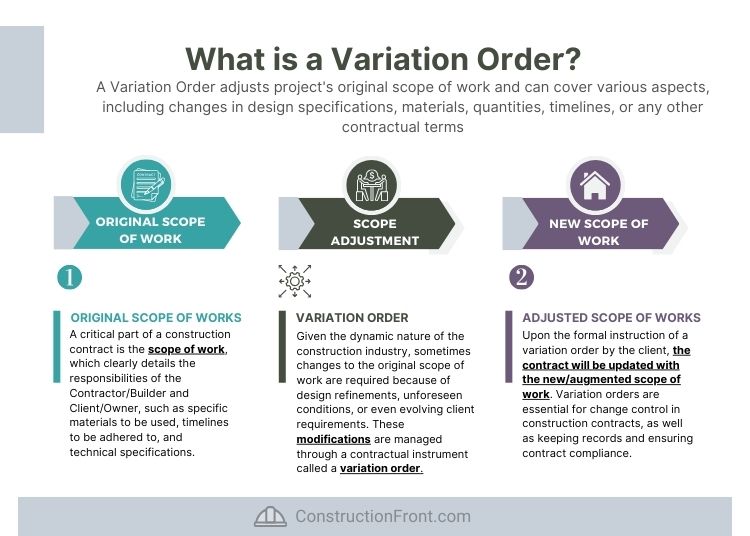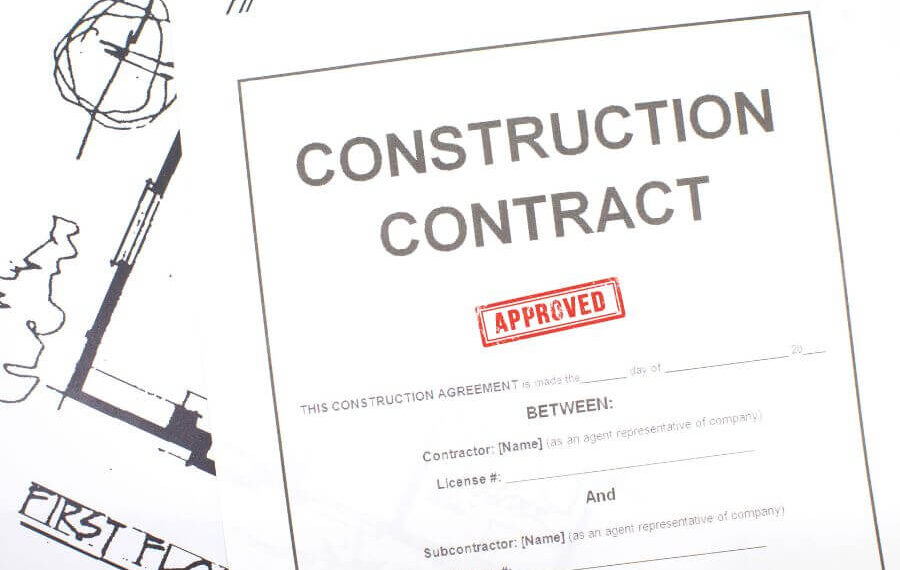Construction projects are known for their dynamic nature, and changes, unfortunately, are common on both large and small-scale contracts. These changes can arise due to various factors, such as design refinements, unforeseen conditions, or even evolving client requirements. These modifications are usually managed through a contractual instrument called a variation order.
A Variation Order is an official document that outlines modifications or adjustments to a project’s original scope of work. Variation orders can cover various aspects, including changes in design specifications, materials, quantities, timelines, or any other contractual terms.
In this article, we further discuss this topic and understand what causes them, the risks associated with variation orders, ways to avoid and manage them, and provide a variation order template for your reference – Let’s dive in!
What is Variation Order in a Construction Contract?
A variation order in a construction contract refers to a formal written instruction issued by the client or the project owner to make changes to the original scope of work. They are important for the following reasons:
- Ensure Clarity and Keep Records: Variation orders must provide clear documentation of changes, reducing the risk of future disputes and misunderstandings by both parties. It is essential to formalize variation orders in writing to protect both the project owner and the contractor. As a best practice, always instruct or request variation orders in written form.
- Contractual Compliance: Construction contracts typically include mechanisms for managing variations. You must follow these mechanisms to ensure contractual compliance and protect your interests under the agreement
- Change Control: Variation orders establish a structured process for managing contract alterations, ensuring clear traceability of all modifications. This is particularly important when multiple interfacing contractors are involved in one project. For example, you will need to understand how a change for a builder will impact the lift installation and minimize potential conflicts.
- Cost and Time Management: Variation orders should clearly state the associated costs and timelines for changes. This enables informed decision-making.

What causes a Variation Order in a Construction Contract?
Various factors can trigger variation orders in construction contracts, such as design update, unforeseen conditions, change of requirements by the owner, scope expansion or reduction, and project’s program updates.
The table below summarises some common causes that lead to agreement amendments, a brief description, and the respective example.
|
Cause |
Description |
Example |
|
Design Changes |
Modifications to the original design or specifications. |
Revising the architectural plans due to aesthetic preferences or changes in functional requirements. |
|
Unforeseen Conditions |
Discovering unforeseen challenges or site conditions during construction. |
Encountering unexpected soil instability that requires additional foundation work. |
|
Client Requirement Changes |
Alterations requested by the client due to evolving needs or preferences. |
Requesting a different color scheme for the interior finishes or changing the layout of a room. |
|
Scope Expansion |
Adding additional work beyond the original contract scope. |
Including an extra building wing or constructing an additional floor in an existing structure. |
|
Schedule Adjustments |
Modifications to the project timeline or sequencing of activities. |
Accelerating the completion date to meet an earlier project delivery deadline. |
|
Material Substitutions |
Replacing specified materials with alternatives. |
Substituting one type of flooring material with another that offers better durability or aesthetics. |
Author’s Note: We note there are other several issues that can lead to change orders in construction agreements, such as changes in regulations or law, site access issues, weather conditions, and value engineering.
What are the risks associated with Variation Orders in a Contract?
Construction projects are inherently dynamic, and changes during their execution are inevitable. Albeit sometimes required and beneficial for the final desired product, variation orders might create significant and unexpected risks to your project, such as:
- Cost Overruns: Changes in scope can lead to additional costs, including revised materials, labour, and equipment requirements,
- Schedule Delays: Variation orders may disrupt the project’s planned timeline, leading to delays in completion due to additional work or rescheduling requirements.
- Contractual Disputes: Inadequate documentation or unclear terms in variation orders can result in contractual conflicts between parties, leading to disputes and potential legal consequences.
- Impacts on Quality: Changes to the original scope may introduce risks to the project’s quality if not adequately managed.
- Miscommunication and Coordination Issues: Lack of clear communication and coordination among the relevant parties may result in errors, rework, and coordination challenges among different trades or contractors.
- Procurement and Supply Chain Challenges: Variation orders may require adjustments to procurement strategies, leading to potential disruptions in the supply chain and difficulties in securing required materials or services. This can be specifically challenging for remote jobs or products with a long lead time.
- Productivity Loss: Changes to the scope of work can affect labour productivity, as workers must adapt to new requirements, potentially impacting overall project efficiency.
- Health and Safety Risks: Variation orders may introduce additional health and safety considerations, requiring updated risk assessments and proper implementation of safety measures.

How to Avoid Variation Orders in Construction Contracts?
As detailed above, variation orders can introduce complexities and potential risks to construction projects. So, how to avoid them? Use the following measures:
- Thorough Project Planning
- Clear and Comprehensive Contracts
- Effective Communication
- Detailed Documentation
- Regular Project Monitoring
- Collaborative approach
- Create and maintain an effective change management procedure
- Implement a robust risk management framework
|
Mitigation Measure |
Desired Outcome |
How to Implement? |
|
Thorough Project Planning |
Minimize unexpected changes and variations |
Conduct comprehensive project planning, including development of detailed design, site condition investigations, accurate cost estimation, and thorough risk assessment. |
|
Clear and Comprehensive Contracts |
Reduce ambiguity and provide a solid foundation for project execution, with clear scope delineation |
Ensure contracts clearly define the scope of work, specifications, timelines, and change management procedures. A matrix of responsibilities might be helpful. |
|
Effective Communication |
Identify potential issues early and facilitate prompt resolution |
Foster open and transparent communication among all project participants, including clients, contractors, and subcontractors. |
|
Detailed Documentation |
Establish a clear audit trail and proper management of variations |
Maintain meticulous documentation throughout the project lifecycle, including meeting minutes, change orders, and relevant correspondence. |
|
Regular Project Monitoring |
Identify emerging issues and intervene timely |
Implement a robust project monitoring system (such as early warning notices – click here to read our article on it), including regular site inspections and progress meetings, to track progress and identify potential issues that might lead to variations. |
|
Collaborative Problem-Solving |
Address potential issues before they escalate into variations |
Encourage collaboration and proactive problem-solving among project stakeholders through regular meetings and open dialogue. |
|
Change Management Procedures |
Properly assess and manage variations in a controlled manner |
Establish a well-defined change management process that includes evaluation, impact assessment, and approval protocols for proposed changes. |
|
Risk Management |
Proactively address potential risks to minimize variations arising from unforeseen circumstances |
Implement a robust risk management framework, including identifying, assessing, and mitigating risks throughout the project lifecycle. |
Author’s Note: Another key aspect of mitigating alterations and amendments in your construction contract is ensuring that the implemented agreement model is adequate.
Each contracting approach (Construction Only, Alliance Contracting, D&C, EPC, etc.) comes with a different risk profile, and you should consider what is the most suitable for the project’s characteristics. If you need some advice, please do not hesitate to contact us (click here)
Variation Order - Template
The template below is generic and very simple, and should be used as a reference only. We strongly recommend taking some specific advice to ensure your rights are reserved and protected.
We offer specialised commercial and contractual advice, and do not hesitate to contact us.
VO - Template
VARIATION ORDER #22
Subject: Variation Order #22 – Additional Excavation Around Piles
Dear Contractor,
The Owner refers to the agreement executed on [date] between the Owner and the Contractor for the Construction of a Warehouse.
Pursuant to clause 10.3, the Owner hereby instructs the Contractor to proceed with the following Variation Order.
- Variation Scope:
The Contractor is directed to undertake additional excavation around piles 1, 2 and 3 as per instructions attached to this notice (include attachment)
- Variation Cost:
The costs associated with this Variation Order are $1,000.00
- Program Impacts:
The Owner understands there are no time impacts associated with this Variation Order.
Should the Contractor have any concerns or queries regarding this Variation Order, please do not hesitate to contact us immediately to discuss and clarify.
Regards,
John C.
Owner’s Representative.
FAQ
What is the difference between a variation order and a claim?
A variation order is a formal change to the original scope of work agreed upon by the parties involved. In contrast, a claim refers to a request for compensation or resolution due to a dispute or disagreement.
Example: A variation claim could arise when unforeseen ground conditions are encountered during excavation (soil loading capacity is lower than expected), requiring additional foundation work and causing delays.
The contractor can submit a variation claim to the owner, outlining the additional costs and time required to address the unexpected ground conditions. The owner needs to review and check Contractor’s entitlement.
Suggested Article: What is a Variation Claim or Variation Request? (And How to Submit one!)
What is the difference between a variation order and a change order?
Variation and change orders are often used interchangeably, and the nomenclature and terminology will vary according to the contract definitions. Some other common terms are:
- Variation Order
- Change Order
- Scope Change
- Contract amendment
- Contract adjustment
- Project Alteration
- Construction Variation
Need Help?
Do not hesitate to contact us (click here) for specialised advice in construction contracts.













